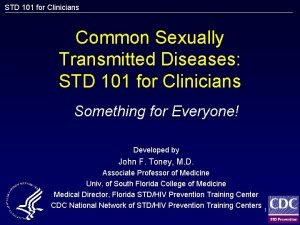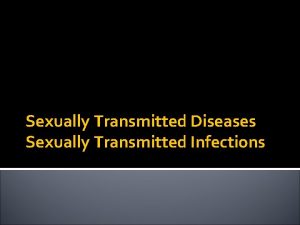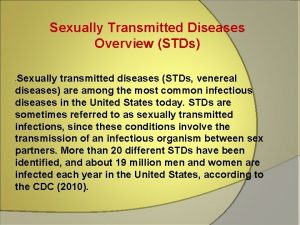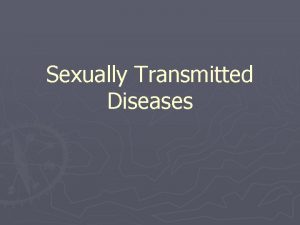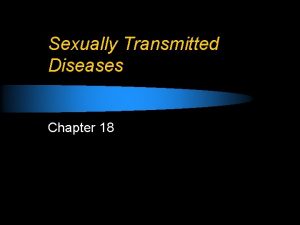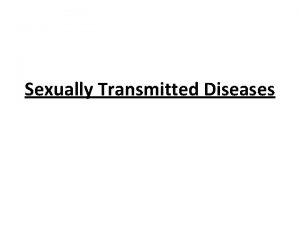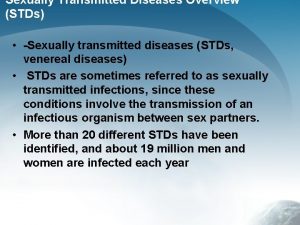Sexually Transmitted Diseases Did you know Also called









- Slides: 9

Sexually Transmitted Diseases

Did you know? § Also called Sexually transmitted infection (STI) § Infections that are spread from one person to another during vaginal, anal or oral sex § 15 -24 year olds are ¼ of active population but = ½ of the 20 million STDs that occur each year in the United States § More than 30 different bacteria/viruses/parasites that are known to be transmitted through sexual contact

• Gonorrhea • Heavy menstrual bleeding or bleeding between periods • Painful bowel movements • Anal itching • Chlamydia Types of STDs Curable • Lower abdominal pain • Pain during intercourse in women • Bleeding between periods in women • Trichomoniasis • Strong vaginal odor • Vaginal itching or irritation • Itching or irritation inside the penis • Pain during intercourse

Early stage symptoms: § a small sore may be present at the site of infection Syphilis § • • • Symptoms can progress to: Rash, small sores over any area of your body Fever Fatigue/aching Symptoms if it goes untreated: • • Lack of coordination Numbness Dementia/behavior changes Headache

§ Herpes • Small red bumps/ blisters/ open sores in the genital area • Pain or itching around the genital area § Human papillomavirus (HPV) • Several warts clustered together Types Incurable • Skin tone or gray in color in the genital area § HIV § Mild, flu like symptoms early on § Fever, weight loss, swollen lymph nodes § Late stage includes headaches, chronic diarrhea, night sweats § Hepatitis B • Nausea/ vomiting • Abdominal pain • Dark urine • Yellowing of your skin and the whites of your eyes (jaundice)

Why is this important? Many STDs show no symptoms – easily passed to a partner without knowing If left untreated, the risk of contracting another STD and could raise the risk of HIV transmission If untreated, it can cause infertility, organ damage, certain types of cancer, passed to child

Treatment § Antibiotics § Antivirals If you or your partner are infected-both need to receive treatment to avoid re -infecting each other

What can you do to protect yourself? § Abstinence § Vaccines § Reduce number of sexual partners § Mutual monogamy § Use condoms § Get tested

References Sexually Transmitted Disease (STD) Symptoms. Mayo Clinic. https: //www. mayoclinic. org/diseases-conditions/sexually-transmitted-diseases-stds/indepth/std-symptoms/art-20047081. Accessed September 8, 2020. Sexually Transmitted Diseases (STDs). Center of Disease Control and Prevention. https: //www. cdc. gov/std/prevention/default. htm. Accessed September 8, 2020. Sexually Transmitted Infections (STIs). World Health Organization. https: //www. who. int/news-room/fact-sheets/detail/sexually-transmitted-infections-(stis). Accessed September 8, 2020.
 Chapter 24 lesson 1 sexually transmitted diseases
Chapter 24 lesson 1 sexually transmitted diseases Chapter 24 sexually transmitted diseases and hiv/aids
Chapter 24 sexually transmitted diseases and hiv/aids Std
Std Nursing management of reproductive tract infection
Nursing management of reproductive tract infection Chapter 25 sexually transmitted infections and hiv/aids
Chapter 25 sexually transmitted infections and hiv/aids Sexually transmitted disease
Sexually transmitted disease A song transmitted orally which tell a story
A song transmitted orally which tell a story Where did you went
Where did you went Fun facts about tea
Fun facts about tea Reported speech negative
Reported speech negative





